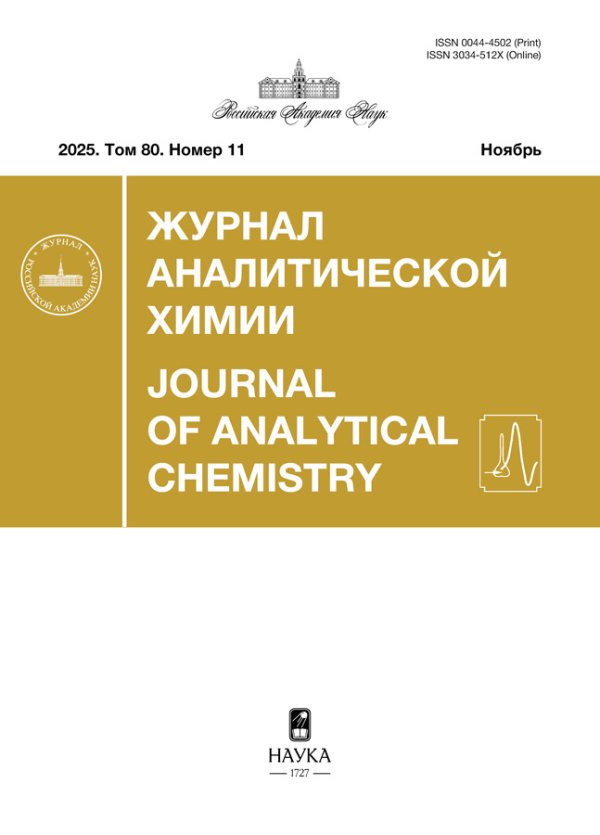Люминесцентное определение дофамина с помощью фотоаппарата
- Авторы: Громова С.А.1, Матяш М.В.1, Апяри В.В.1, Дмитриенко С.Г.1, Золотов Ю.А.1,2
-
Учреждения:
- Московский государственный университет имени М.В. Ломоносова
- Институт общей и неорганической химии им. Н.С. Курнакова РАН
- Выпуск: Том 80, № 1 (2025)
- Страницы: 52-61
- Раздел: ОРИГИНАЛЬНЫЕ СТАТЬИ
- Статья получена: 28.05.2025
- URL: https://gynecology.orscience.ru/0044-4502/article/view/680889
- DOI: https://doi.org/10.31857/S0044450225010054
- EDN: https://elibrary.ru/aasvru
- ID: 680889
Цитировать
Полный текст
Аннотация
Показано, что взаимодействие дофамина с флуорескамином может быть положено в основу люминесцентного определения дофамина с использованием фотоаппарата, поскольку образующийся в результате этого взаимодействия продукт характеризуется максимумом люминесценции в видимой области (485 нм), и для возбуждения люминесценции достаточно светодиода, излучающего свет в ближней ультрафиолетовой области (395 нм). Реакцию следует проводить при рН 8–8.5 в фосфатном буферном растворе в течение 5 мин, флуорескамин в реакционную смесь стоит вводить в последнюю очередь. Оценены некоторые аналитические характеристики определения с помощью фотоаппарата и проведено их сравнение с характеристиками аналогичного определения дофамина с использованием профессионального спектрофлуориметра и спектрофотометра. Пределы обнаружения дофамина с помощью фотоаппарата, спектрофотометра и спектрофлуориметра составили 1.8, 1.6 и 0.5 мкМ, диапазон определяемых содержаний 5.4–50 мкМ, 4.8–100 мкМ, 1.5–100 мкМ соответственно. Определению не мешает присутствие распространенных неорганических ионов, содержание которых в 10 раз превышает содержание дофамина. Предложенный способ определения дофамина может быть использован для контроля качества лекарственных препаратов.
Ключевые слова
Полный текст
Об авторах
С. А. Громова
Московский государственный университет имени М.В. Ломоносова
Email: masha13_1992@mail.ru
Россия, Ленинские горы, 1, Москва, 119991
М. В. Матяш
Московский государственный университет имени М.В. Ломоносова
Автор, ответственный за переписку.
Email: masha13_1992@mail.ru
Россия, Ленинские горы, 1, Москва, 119991
В. В. Апяри
Московский государственный университет имени М.В. Ломоносова
Email: masha13_1992@mail.ru
Россия, Ленинские горы, 1, Москва, 119991
С. Г. Дмитриенко
Московский государственный университет имени М.В. Ломоносова
Email: masha13_1992@mail.ru
Россия, Ленинские горы, 1, Москва, 119991
Ю. А. Золотов
Московский государственный университет имени М.В. Ломоносова; Институт общей и неорганической химии им. Н.С. Курнакова РАН
Email: masha13_1992@mail.ru
Россия, Ленинские горы, 1, Москва, 119991; Ленинский просп., 31, Москва, 119991
Список литературы
- Апяри В.В., Горбунова М.В., Исаченко А.И., Дмитриенко С.Г., Золотов Ю.А. Использование бытовых цветорегистрирующих устройств в количественном химическом анализе // Журн. аналит. химии. 2017. Т. 72. № 11. С. 963. https://doi.org/10.7868/S0044450217110019 (Apyari V.V., Gorbunova M.V., Isachenko A.I., Dmitrienko S.G., Zolotov Yu A. Use of household color-recording devices in quantitative chemical analysis // J. Anal. Chem. 2017. V. 72. № 11. P. 1127. https://doi.org/10.1134/S106193481711003X)
- Моногарова О.В., Осколок К.В., Апяри В.В. Цветометрия в химическом анализе // Журн. аналит. химии. 2018. Т. 73. № 11. С. 857. https://doi.org/10.1134/S0044450218110063 (Monogarova O.V., Oskolok K.V., Apyari V.V. Colorimetry in chemical analysis // J. Anal. Chem. 2018. V. 73. P. 1076. https://doi.org/10.1134/S1061934818110060)
- Lapresta-Fernández A., Capitán-Vallvey L.F. Environmental monitoring using a conventional photographic digital camera for multianalyte disposable optical sensors // Anal. Chim. Acta. 2011. V. 706. № 2. P. 328. https://doi.org/10.1016/j.aca.2011.08.042
- Doeven E.H., Barbante G.J., Kerr E., Hogan C.F., Endler J.A., Francis P.S. Red–green–blue electrogenerated chemiluminescence utilizing a digital camera as detector // Anal. Chem. 2014. V. 86. № 5. P. 2727. https://doi.org/10.1021/ac404135f
- Jayawardane B.M., McKelvie I.D., Kolev S.D. A paper-based device for measurement of reactive phosphate in water // Talanta. 2012. V. 100. P. 454. https://doi.org/10.1016/j.talanta.2012.08.021
- Gárcia A., Erenas M.M., Marinetto E.D., Abad C.A., de Orbe-Payá I., Palma A.J., CapitánVallvey L.F. Mobile phone platform as portable chemical analyzer // Sens. Actuators B. 2011. V. 156. № 1. P. 350. https://doi.org/10.1016/j.snb.2011.04.045
- Shahvar A., Saraji M., Shamsaei D. Smartphone-based chemiluminescence sensing for TLC imaging // Sens. Actuators B: Chem. 2018. V. 255. P. 891. https://doi.org/10.1016/j.snb.2017.08.144
- Apyari V.V., Dmitrienko S.G., Zolotov Y.A. Unusual application of common digital devices: Potentialities of Eye-One Pro mini-spectrophotometer – A monitor calibrator for registration of surface plasmon resonance bands of silver and gold nanoparticles in solid matrices // Sens. Actuators B: Chem. 2013. V. 188. P. 1109. https://doi.org/10.1016/j.snb.2013.07.097
- Marchenko D.Y., Petrov S.I., Sandzhieva D.A., Dedov A.G. Express method of the quantitative determination of nitrites by computer colorimetry using new reagent compositions // Theor. Found. Chem. Eng. 2016. V. 50. P. 648. https://doi.org/10.1134/S0040579516040187
- Gorbunova M.V., Evstigneeva P.Yu., Apyari V.V., Dmitrienko S.G. A monitor calibrator as a portable tool for determination of luminescent compounds // IEEE Trans. Instrum. Meas. 2021. V. 70. Article 6002910. https://doi.org/10.1109/TI M.2020.3041390
- Gorbunova M.V., Safronova A.S., Vasilyeva A.A., Spitsyna K.S., Apyari V.V., Dmitrienko S.G. Sulfonamide drugs: Low-cost spectrofluorometric determination using a computer monitor calibrator for detection // Talanta. 2023. V. 257. Article 124383 https://doi.org/10.1016/j.talanta.2023.124383
- Кулинский В.И., Колесниченко Л.С. Катехоламины: биохимия, фармакология, физиология, клиника // Вопросы медицинской химии. 2002. Т. 48. № 1. С. 44.
- Derayea S.M., Samir E. A review on the use of fluorescamine as versatile and convenient analytical probe // Microchem. J. 2020. V. 156. Article 104835 https://doi.org/10.1016/j.microc.2020.104835
- Imai K. Fluorimetric assay of dopamine, nerepinephrine and their 3-o-methyl metabolites by using fluorescamine // J. Chromatogr. A. 1975. V. 105. P. 135. https://doi.org/10.1016/S0021-9673(01)81097-9
- Imai K., Tamura Z. Liquid chromatographic determination of urinary dopamine and norepinephrine as fluorescamine derivatives // Clin. Chim. Acta. 1978. V. 85. P. 1. https://doi.org/10.1016/0009-8981(78)90093-1
- Nakamura H., Pisano J.J. Specific detection of primary catecholamines and their 3-o-methyl derivatives on thin-layer plates using a fluorigenic reaction with fluorescamine // J. Chromatogr. A. 1978. V. 154. P. 39. https://doi.org/10.1016/S0021-9673(00)88479-4
- Ingles D.L., Gallimore D. High-performance liquid chromatography of fluorescamine-labelled amines in acid solvents // J. Chromatogr. A. 1985. V. 325. P. 346. https://doi.org/10.1016/S0021-9673(00)96042-4
- Djozan Dj., Farajzadeh M.A. The use of fluorescamine (Fluram) in fluorimetric trace analysis of primary amines of pharmaceutical and biological interest // J. Pharm. Biomed. Anal. 1992. V. 10. P. 1063. https://doi.org/10.1016/0731-7085(91)80120-X
- Толмачева В.В., Ярыкин Д.И., Горбунова М.В., Апяри В.В., Дмитриенко С.Г., Золотов Ю.А. Концентрирование катехоламинов на сверхсшитом полистироле и их определение методом высокоэффективной жидкостной хроматографии // Журн. аналит. химии. 2019. Т. 74. № 11. С. 803. https://doi.org/10.1134/S004445021909010X (Tolmacheva V.V., Yarykin D.I., Gorbunova M.V., Apyari V.V., Dmitrienko S.G., Zolotov Yu A. Preconcentration of catecholamins on hypercrosslinked polystyrene and their determination by high-performance liquid chromatography // J. Anal. Chem. 2019. V. 74. № 11. P. 1057. https://doi.org/10.1134/S1061934819090107)
Дополнительные файлы















